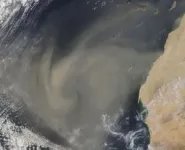(Press-News.org) The study by Maarten van Herpen et al., entitled “Photocatalytic Chlorine Atom Production on Mineral Dust-Sea Spray Aerosols over North Atlantic,” was funded in part by the NGO Spark Climate Solutions. It incorporates a proposed new mechanism whereby blowing mineral dust mixes with sea-spray to form Mineral Dust-Sea Spray Aerosol (MDSA).
The results suggest that MDSA is activated by sunlight to produce an abundance of chlorine atoms, which oxidize atmospheric methane and tropospheric ozone via photocatalysis. Largely composed of blowing dust from the Sahara Desert combined with sea salt aerosol from the ocean, MDSA is the dominant source of atmospheric chlorine over the North Atlantic, the study finds.
The study relies on a combination of global modeling and laboratory and field observations, including air samples from Barbados showing seasonal depletion of the stable isotope 13CO, an anomaly which puzzled scientists for 20 years. They knew observed changes in 13CO and C18O were evidence of chlorine atoms reacting with methane, and that carbon monoxide is the first stable product in atmospheric methane oxidation. But the known sources of atmospheric chlorine could not account for the degree of depletion in 13CO, until now.
Using a global 3-D chemistry-climate model (CAM-Chem), van Herpen et al. found that when increased chlorine from the MDSA mechanism was incorporated into the model, the results agreed well with the Barbados data and explained the 13CO depletion.
If the MDSA effect observed in the North Atlantic is extrapolated globally, and if its efficiency is similar in other parts of the world —two areas that aren’t yet well understood and require further research— global atmospheric chlorine concentrations might be roughly 40% higher than previously estimated, the study finds. Factoring this into global methane modeling could potentially shift our understanding of the relative proportions of methane emissions sources.
Methane is a potent greenhouse gas, with a Global Warming Potential (GWP) 83 times higher than carbon dioxide over 20 years and 30 times higher over 100 years, accounting for about a third of modern warming. Atmospheric methane concentrations, now nearly 2.6 times higher than in pre-industrial times, are rising at an accelerating rate, with the largest annual increases on record occurring in 2020 and 2021. Anthropogenic methane emissions are known to be the cause of the majority of the overall rise, with elevated natural emissions and atmospheric chemistry changes resulting from anthropogenic emissions of various gases also playing a part.
While the reason for the recent acceleration is not well understood, the van Herpen et al. study may have found an important clue. Its conclusion that there is greater active chlorine than previously thought, impacting 13C, indicates a possible increase in methane from biological sources such as agriculture and wetlands. This suggests biological methane may have played a slightly larger role than previously estimated.
“Methane emissions from biological sources such as wetlands and agriculture may be growing as global temperatures rise,” said Maarten van Herpen, lead author of the PNAS study. “But recent increases in dust from North Africa have probably increased methane oxidation in the atmosphere, partly masking the growth in biological methane emissions. Adjusting atmospheric modeling to take this into account may show that methane emissions from biological sources are rising even faster than we thought.”
“When these findings are incorporated into methane budgets it is likely to increase our assessment of how much methane comes from biological sources,” said University of Copenhagen professor Matthew Johnson, who co-authored the study. “While methane oxidation from MDSA is relatively small in terms of global methane, our data shows it is causing large changes in the abundance of 13C in methane, which is used to determine source contributions. The past few years have seen atmospheric methane increase at an increasing rate, more than ever before, and it is important to understand the cause. Models need to take the revised chlorine isotope shift into account to get a clear picture of the increase in biological methane, which has been identified as a critical tipping point.”
How the MDSA mechanism may operate in other parts of the world is not well understood and requires further research, the study argues. Follow-on research is underway.
“Our current research is focused on getting a better understanding of what exactly influences how much methane MDSA particles are removing from the atmosphere,” said van Herpen, “To do that, we are analyzing air samples from across the North Atlantic, provided by atmospheric observatories and commercial ships. Seafarers are helping advance our research by filling flasks with air as they cross through the African dust cloud. We have collected 500 flasks so far. Early results are looking very encouraging, but we need a full year of data before we can draw conclusions.”
END
Sahara dust can enhance removal of methane
New study improves our understanding of the global methane budget
2023-07-24
ELSE PRESS RELEASES FROM THIS DATE:
Unlocking secrets of the elusive ghost shark
2023-07-24
Researchers from the University of Florida and the Seattle Aquarium are exploring 100 meters underwater in the Pacific Northwest this summer to learn more about mysterious ghost sharks, one of the strangest beasts from the depths of the ocean.
Using remotely operated underwater vehicles, or ROVs, the scientists searched for nesting grounds of the Pacific spotted ratfish, Hydrolagus colliei, a ghostlike fish that lurks on the ocean floor.
“We know very little about these elusive relatives of sharks and even less about their spawning habits and embryonic development,” said ...
Risk of fatal heart attack may double in heat wave & high fine particulate pollution days
2023-07-24
Research Highlights:
An analysis of more than 202,000 heart attack deaths between 2015-2020 in a single Chinese province found that days that had extreme heat, extreme cold or high levels of fine particulate matter (PM2.5) air pollution were significantly associated with the risk of death from a heart attack, especially in women and older adults.
The greatest increase in the risk of death from heart attack was seen on days that had the combination of extreme heat and high levels of PM2.5.
The days with extreme heat were associated ...
Study shows positive outcomes for first three U.S. living HIV-to-HIV kidney transplant donors
2023-07-24
Based on findings from a study published today in the journal, The Lancet Regional Health – Americas, researchers at Johns Hopkins Medicine and three collaborating medical institutions suggest that people living with the human immunodeficiency virus (HIV) who donate a kidney to other people living with HIV (PLWH) have a low risk of developing end-stage kidney disease (ESKD) or other kidney problems in the years following the donation.
“This new evidence is proof-of-concept that donating a kidney can be safe for people living with HIV,” says Christine Durand, M.D., associate professor of medicine at Johns ...
Webb detects water vapor in rocky planet-forming zone
2023-07-24
Water is essential for life as we know it. However, scientists debate how it reached the Earth and whether the same processes could seed rocky exoplanets orbiting distant stars. New insights may come from the planetary system PDS 70, located 370 light-years away. The star hosts both an inner disk and outer disk of gas and dust, separated by a 5 billion-mile-wide (8 billion kilometer) gap, and within that gap are two known gas-giant planets.
New measurements by NASA’s James Webb Space Telescope’s MIRI (Mid-Infrared Instrument) have detected water vapor in the system’s inner disk, at distances ...
Diagnosis of cystic fibrosis often missed or delayed, especially in non-White infants
2023-07-24
Ann & Robert H. Lurie Children’s Hospital of Chicago is leading an awareness campaign that aims to reduce missed or delayed diagnosis of cystic fibrosis after newborn screening, especially in non-White infants. In its first phase, the campaign targets primary care providers and public health officials, so that treatment can start earlier, which is linked to better outcomes for people with cystic fibrosis. The general public phase is expected to follow within the year.
Funded by the Centers for Disease Control and Prevention ...
Potent anti-cancer therapy created using ‘click chemistry’
2023-07-24
A potent anti-cancer therapy has been created using Nobel prize-winning “click chemistry”, where molecules click together like LEGO bricks, in a new study by UCL and Stanford University researchers.
The study, published in Nature Chemistry, opens up new possibilities for how cutting-edge cancer immunotherapies might be built in future.
The research team created an anti-cancer therapy with three components: one targeting the cancer cell, another recruiting a white blood cell called a T cell to attack the cancer cell, and a third knocking out part of the cancer cell’s defences.
Previously, ...
Claire K. Ankuda, MD, MPH (Mount Sinai Health System) recognized with AFAR 2023 Rising Star Award in Health Services and Aging Research
2023-07-24
New York, NY – The American Federation for Aging Research (AFAR), a national non-profit organization whose mission is to support and advance healthy aging through biomedical research, is proud to recognize the outstanding contributions of Claire K. Ankuda, MD, MPH, MSc with the 2023 Terrie Fox Wetle Rising Star Award in Health Services and Aging Research.
This award honors a health services researcher in an early or middle phase of his/her career who has already made important contributions with work that respects the value of multidisciplinary health services ...
Ming Xu, PhD (UConn) receives AFAR 2023 Vincent Cristofalo Rising Star Award in Aging Research
2023-07-24
New York, NY – The American Federation for Aging Research (AFAR), a national non-profit organization whose mission is to support and advance healthy aging through biomedical research, is pleased to recognize the exemplary contributions of Ming Xu, PhD, to the field of aging research through the 2023 Vincent Cristofalo Rising Star Award in Aging Research.
This award is named in honor of the late Dr. Cristofalo, who dedicated his career to aging research and to encouraging young scientists to investigate important problems in the biology of aging. Established in 2008, the award is a ...
NIH researcher Rafael de Cabo, PhD receives AFAR 2023 Irving S. Wright Award of Distinction
2023-07-24
The American Federation for Aging Research (AFAR), a national non-profit organization whose mission is to support and advance healthy aging through biomedical research, is pleased to recognize the exemplary contributions of Rafael de Cabo, PhD, to the field of aging research through the 2023 Irving S. Wright Award of Distinction.
This award is named in honor of AFAR’s founder and recognizes exceptional contributions to basic or clinical research in the field of aging. Established in 1982, the award is a framed citation and carries a cash prize of $5,000.
Dr. de Cabo is Senior Investigator of the ...
Muscadine wine shows promise in improving aging skin
2023-07-24
Could muscadine wine help perk up sagging skin? According to a new study, women who drank two glasses of dealcoholized muscadine wine daily showed significant improvements in the elasticity and water retention of their skin compared with those who consumed a placebo.
The study is the first time scientists have studied the impacts of nonalcoholic wine consumption on skin health in a randomized clinical trial. Researchers attribute the beneficial effects to chemical compounds called polyphenols that naturally occur in many plants.
“Muscadine grapes have been found to have a unique polyphenolic profile in comparison to other red wine varieties,” ...
LAST 30 PRESS RELEASES:
New expert guidance urges caution before surgery for patients with treatment-resistant constipation
Solar hydrogen can now be produced efficiently without the scarce metal platinum
Sleeping in on weekends may help boost teens’ mental health
Study: Teens use cellphones for an hour a day at school
After more than two years of war, Palestinian children are hungry, denied education and “like the living dead”
The untold story of life with Prader-Willi syndrome - according to the siblings who live it
How the parasite that ‘gave up sex’ found more hosts – and why its victory won’t last
When is it time to jump? The boiling frog problem of AI use in physics education
Twitter data reveals partisan divide in understanding why pollen season's getting worse
AI is quick but risky for updating old software
Revolutionizing biosecurity: new multi-omics framework to transform invasive species management
From ancient herb to modern medicine: new review unveils the multi-targeted healing potential of Borago officinalis
Building a global scientific community: Biological Diversity Journal announces dual recruitment of Editorial Board and Youth Editorial Board members
Microbes that break down antibiotics help protect ecosystems under drug pollution
Smart biochar that remembers pollutants offers a new way to clean water and recycle biomass
Rice genes matter more than domestication in shaping plant microbiomes
Ticking time bomb: Some farmers report as many as 70 tick encounters over a 6-month period
Turning garden and crop waste into plastics
Scientists discover ‘platypus galaxies’ in the early universe
Seeing thyroid cancer in a new light: when AI meets label-free imaging in the operating room
Neutrophil-to-lymphocyte ratio may aid risk stratification in depressive disorder
2026 Seismological Society of America Annual Meeting
AI-powered ECG analysis offers promising path for early detection of chronic obstructive pulmonary disease, says Mount Sinai researchers
GIMM uncovers flaws in lab-grown heart cells and paves the way for improved treatments
Cracking the evolutionary code of sleep
Medications could help the aging brain cope with surgery, memory impairment
Back pain linked to worse sleep years later in men over 65, according to study
CDC urges ‘shared decision-making’ on some childhood vaccines; many unclear about what that means
New research finds that an ‘equal treatment’ approach to economic opportunity advertising can backfire
Researchers create shape-shifting, self-navigating microparticles
[Press-News.org] Sahara dust can enhance removal of methaneNew study improves our understanding of the global methane budget








